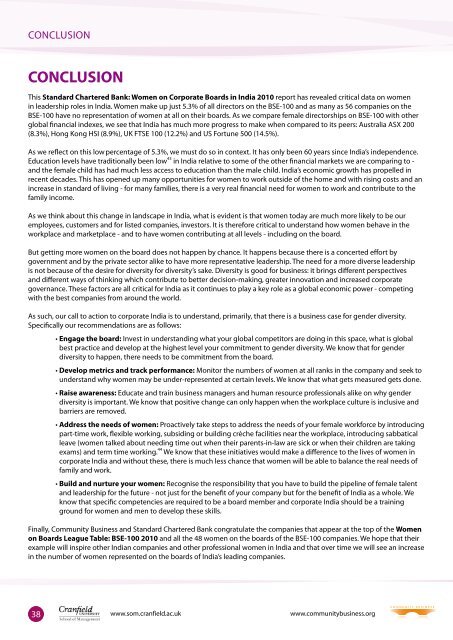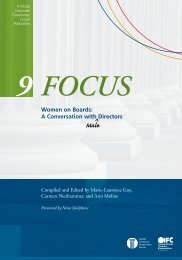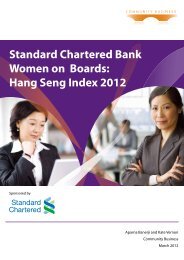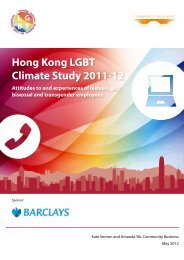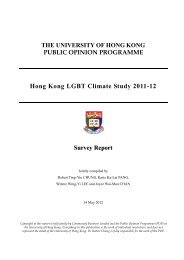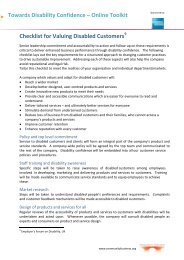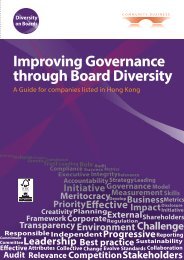Standard Chartered Bank: Women on Corporate Boards in India 2010
Standard Chartered Bank: Women on Corporate Boards in India 2010
Standard Chartered Bank: Women on Corporate Boards in India 2010
Create successful ePaper yourself
Turn your PDF publications into a flip-book with our unique Google optimized e-Paper software.
CONCLUSION<br />
CONCLUSION<br />
This <str<strong>on</strong>g>Standard</str<strong>on</strong>g> <str<strong>on</strong>g>Chartered</str<strong>on</strong>g> <str<strong>on</strong>g>Bank</str<strong>on</strong>g>: <str<strong>on</strong>g>Women</str<strong>on</strong>g> <strong>on</strong> <strong>Corporate</strong> <strong>Boards</strong> <strong>in</strong> <strong>India</strong> <strong>2010</strong> report has revealed critical data <strong>on</strong> women<br />
<strong>in</strong> leadership roles <strong>in</strong> <strong>India</strong>. <str<strong>on</strong>g>Women</str<strong>on</strong>g> make up just 5.3% of all directors <strong>on</strong> the BSE-100 and as many as 56 companies <strong>on</strong> the<br />
BSE-100 have no representati<strong>on</strong> of women at all <strong>on</strong> their boards. As we compare female directorships <strong>on</strong> BSE-100 with other<br />
global f<strong>in</strong>ancial <strong>in</strong>dexes, we see that <strong>India</strong> has much more progress to make when compared to its peers: Australia ASX 200<br />
(8.3%), H<strong>on</strong>g K<strong>on</strong>g HSI (8.9%), UK FTSE 100 (12.2%) and US Fortune 500 (14.5%).<br />
As we reflect <strong>on</strong> this low percentage of 5.3%, we must do so <strong>in</strong> c<strong>on</strong>text. It has <strong>on</strong>ly been 60 years s<strong>in</strong>ce <strong>India</strong>’s <strong>in</strong>dependence.<br />
Educati<strong>on</strong> levels have traditi<strong>on</strong>ally been low 43 <strong>in</strong> <strong>India</strong> relative to some of the other f<strong>in</strong>ancial markets we are compar<strong>in</strong>g to -<br />
and the female child has had much less access to educati<strong>on</strong> than the male child. <strong>India</strong>’s ec<strong>on</strong>omic growth has propelled <strong>in</strong><br />
recent decades. This has opened up many opportunities for women to work outside of the home and with ris<strong>in</strong>g costs and an<br />
<strong>in</strong>crease <strong>in</strong> standard of liv<strong>in</strong>g - for many families, there is a very real f<strong>in</strong>ancial need for women to work and c<strong>on</strong>tribute to the<br />
family <strong>in</strong>come.<br />
As we th<strong>in</strong>k about this change <strong>in</strong> landscape <strong>in</strong> <strong>India</strong>, what is evident is that women today are much more likely to be our<br />
employees, customers and for listed companies, <strong>in</strong>vestors. It is therefore critical to understand how women behave <strong>in</strong> the<br />
workplace and marketplace - and to have women c<strong>on</strong>tribut<strong>in</strong>g at all levels - <strong>in</strong>clud<strong>in</strong>g <strong>on</strong> the board.<br />
But gett<strong>in</strong>g more women <strong>on</strong> the board does not happen by chance. It happens because there is a c<strong>on</strong>certed effort by<br />
government and by the private sector alike to have more representative leadership. The need for a more diverse leadership<br />
is not because of the desire for diversity for diversity’s sake. Diversity is good for bus<strong>in</strong>ess: it br<strong>in</strong>gs different perspectives<br />
and different ways of th<strong>in</strong>k<strong>in</strong>g which c<strong>on</strong>tribute to better decisi<strong>on</strong>-mak<strong>in</strong>g, greater <strong>in</strong>novati<strong>on</strong> and <strong>in</strong>creased corporate<br />
governance. These factors are all critical for <strong>India</strong> as it c<strong>on</strong>t<strong>in</strong>ues to play a key role as a global ec<strong>on</strong>omic power - compet<strong>in</strong>g<br />
with the best companies from around the world.<br />
As such, our call to acti<strong>on</strong> to corporate <strong>India</strong> is to understand, primarily, that there is a bus<strong>in</strong>ess case for gender diversity.<br />
Specifically our recommendati<strong>on</strong>s are as follows:<br />
• Engage the board: Invest <strong>in</strong> understand<strong>in</strong>g what your global competitors are do<strong>in</strong>g <strong>in</strong> this space, what is global<br />
best practice and develop at the highest level your commitment to gender diversity. We know that for gender<br />
diversity to happen, there needs to be commitment from the board.<br />
• Develop metrics and track performance: M<strong>on</strong>itor the numbers of women at all ranks <strong>in</strong> the company and seek to<br />
understand why women may be under-represented at certa<strong>in</strong> levels. We know that what gets measured gets d<strong>on</strong>e.<br />
• Raise awareness: Educate and tra<strong>in</strong> bus<strong>in</strong>ess managers and human resource professi<strong>on</strong>als alike <strong>on</strong> why gender<br />
diversity is important. We know that positive change can <strong>on</strong>ly happen when the workplace culture is <strong>in</strong>clusive and<br />
barriers are removed.<br />
• Address the needs of women: Proactively take steps to address the needs of your female workforce by <strong>in</strong>troduc<strong>in</strong>g<br />
part-time work, flexible work<strong>in</strong>g, subsid<strong>in</strong>g or build<strong>in</strong>g crèche facilities near the workplace, <strong>in</strong>troduc<strong>in</strong>g sabbatical<br />
leave (women talked about need<strong>in</strong>g time out when their parents-<strong>in</strong>-law are sick or when their children are tak<strong>in</strong>g<br />
exams) and term time work<strong>in</strong>g. 44 We know that these <strong>in</strong>itiatives would make a difference to the lives of women <strong>in</strong><br />
corporate <strong>India</strong> and without these, there is much less chance that women will be able to balance the real needs of<br />
family and work.<br />
• Build and nurture your women: Recognise the resp<strong>on</strong>sibility that you have to build the pipel<strong>in</strong>e of female talent<br />
and leadership for the future - not just for the benefit of your company but for the benefit of <strong>India</strong> as a whole. We<br />
know that specific competencies are required to be a board member and corporate <strong>India</strong> should be a tra<strong>in</strong><strong>in</strong>g<br />
ground for women and men to develop these skills.<br />
F<strong>in</strong>ally, Community Bus<strong>in</strong>ess and <str<strong>on</strong>g>Standard</str<strong>on</strong>g> <str<strong>on</strong>g>Chartered</str<strong>on</strong>g> <str<strong>on</strong>g>Bank</str<strong>on</strong>g> c<strong>on</strong>gratulate the companies that appear at the top of the <str<strong>on</strong>g>Women</str<strong>on</strong>g><br />
<strong>on</strong> <strong>Boards</strong> League Table: BSE-100 <strong>2010</strong> and all the 48 women <strong>on</strong> the boards of the BSE-100 companies. We hope that their<br />
example will <strong>in</strong>spire other <strong>India</strong>n companies and other professi<strong>on</strong>al women <strong>in</strong> <strong>India</strong> and that over time we will see an <strong>in</strong>crease<br />
<strong>in</strong> the number of women represented <strong>on</strong> the boards of <strong>India</strong>’s lead<strong>in</strong>g companies.<br />
38<br />
www.som.cranfield.ac.uk<br />
www.communitybus<strong>in</strong>ess.org


